The custom of many countries during Christmas is to always encourage children to do good deeds so they can receive gifts from Santa Claus. Besides, it also intends to warn children that they will receive punishment for their bad behavior.
The characters appearing in Christmas stories are not only the benevolent Santa Claus but also villains – the devil who always makes children scared, making them more obedient. These villains appear with many names, images and in different locations…
1. Christmas Cat
The Yule Cat or Christmas Cat is a monster that appears in Icelandic folklore. The Yule Cat is described as very large and evil, lurking in the snowy countryside during Christmas and eating anyone who doesn’t have new clothes to wear before Christmas.
According to the custom of many Icelandic families, those who complete their work on time will be paid to buy new clothes for Christmas, but those who are lazy will not.
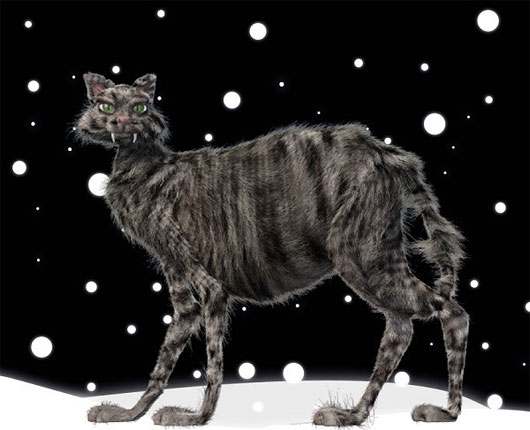
To encourage children to work hard, parents often tell the story of the Yule cat and say that Yule always knows which children are lazy so he can eat them. The fear of being eaten by the Yule Cat is considered by Icelanders as a motivation to help raise morale and responsibility in harvesting crops before Christmas.
At the same time, it serves as a reminder for children to work hard and help their parents get new clothes. Therefore, it is not surprising that many people note that Icelanders always spend more time working than other Europeans.
2. The witch Frau Perchta
Stories told in Germany and Austria portrayed a witch named Frau Perchta . She is the one who has the power to “give” rewards and punishments for 12 days during Christmas.

Frau Perchta is also better known for her hobby of punishing criminals with bizarre methods. That is to separate their internal organs from the body and replace them with garbage.
Perchta’s story is said to have originated from a legendary Alpine nymph – the goddess of nature , who remained hidden in the woods throughout the year and only communicated with humans during Christmas. The goddess will always observe every human action throughout the year and punish anyone who commits many sins this Christmas.
3. Zwarte Piet the chimney sweep
Zwarte Piet or Black Peter is Santa’s assistant in Dutch tales. Although he is not a monster, he is someone who will punish those who have a bad attitude or misbehave during Christmas.

Many recorded documents show that, around the 1850s, children who were not well-behaved were often threatened that Zwarte Piet would kidnap them away from their parents and take them to distant Spain. He is described with a large appearance and a face as black as coal.
Besides, many other versions say that he was a chimney sweep, so he had such a black face.
4. The scowling old man Belsnickel
Belsnickel is a male character in legends in southwestern Germany . During the period 1 – 2 weeks before Christmas, Belsnickels often appear in front of houses and scare children, especially those who like to play around and do not listen to their parents.
He often wears ragged, dirty clothes with a frowning, domineering look on his face. In his hand he always held a stick or dry tree branch as if ready to beat naughty children.

There are other versions that say: to test the children’s honesty and actions, he often asked them to sing or answer questions. If he is good, he will throw candy on the ground, but if he encounters bad children, they will not escape his stick.
Even though they are not injured, they always feel scared and try to become more obedient to receive gifts from Santa Claus on Christmas Eve. This tradition of children trying to be obedient and obedient to their parents also exists in some other areas in Newfoundland (Canada) or some Brazilian communities in the state of Santa Catarina.
5. Devil Krampus
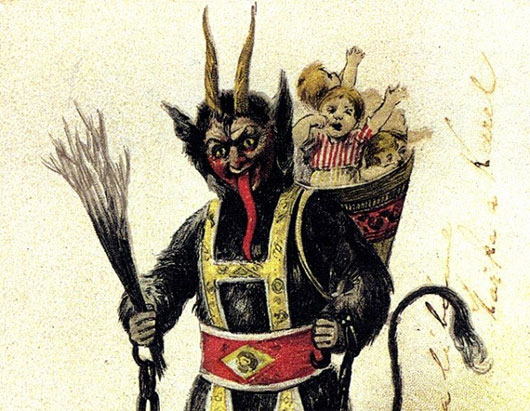
Krampus means “claw” , and this creature is described as having a demonic appearance . This creature has its origins in German folklore, however, its influence has spread far beyond Germany’s borders, to Austria, Hungary, Slovenia…
For people living in the Alps, besides Santa Claus, this is also an indispensable character in every Christmas season. Accordingly, Krampus is described as the embodiment of the devil with a half-man, half-goat body, long horns and a mustache. He wears a string of bells and a bundle of birch sticks to spank bad children (contrary to the image of Santa Claus giving gifts to children).
Krampus’s appearance varies depending on region and country: he can have a face reminiscent of a demon, goat, or bat, but can also be… cute like a Snowman.
However, the image of this devil always has a few characteristic features: dark hair, one humanoid leg and one… horse’s leg, along with a long, pointed tongue hanging down.

Initially, Krampus had nothing to do with Christianity. He is said to be the son of the god Hel in Norse mythology.
However, there is no accurate record of the origin of this demon. According to some information, the legend of Krampus is said to originate from oral stories from before BC. But it was only in the 17th century that Krampus was included on Christmas day with Saint Nicholas (the reincarnation of Santa Claus) and was considered his “evil version” .
Why the evil version? That’s because Saint Nicholas Day is celebrated on December 6 in many European countries. And right before this holiday, December 5, will be the day that Krampus reigns.
According to legend, on the night of December 5, this devil will visit every house – just like Santa Claus. However, instead of giving children gifts and candy, Krampus will beat bad children with a stick.
He will even lock them in a sack and throw them into the stream, or more simply… take them straight to hell.
So on this day, people in Austria and some European countries will disguise themselves as Krampus demons and participate in the Krampuslauf race .
They often wear carved wooden masks, bells, necklaces and elaborately designed Krampus costumes to race through town.
A special feature of this race is that they also have the right to… beat the audience. Like the image of Krampus hitting children with birch branches, festival participants on this day can do the same. They often target the legs and thighs, and the victims are mainly teenagers.
And because of the spirit of the festival, the bruises and jitters that viewers have to endure can be forgiven.
Another tradition in Styria (a state in southeastern Austria) that is still maintained today is that a Krampus impersonator will go to each house with gold-painted birch branches to give to children.
Families will hang this tree branch on the wall for the next year to “remind” their children to be obedient if they don’t want to be beaten by Krampus.
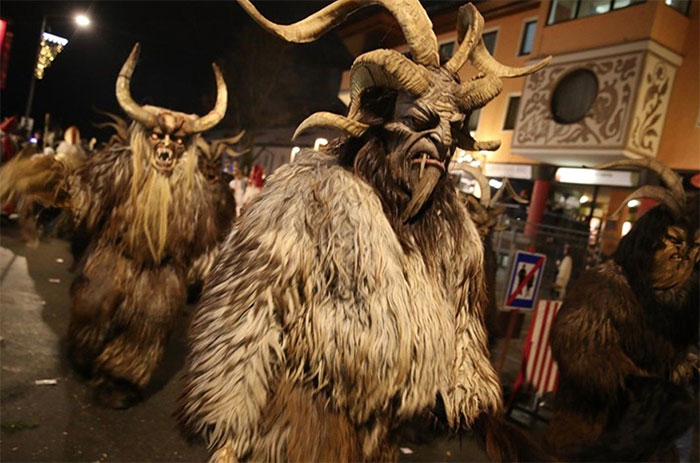
Today, the wooden mask used in Krampus races is considered a traditional art product worth preserving. They are often meticulously hand-carved and all have different unique motifs.
In the two cities of Kitzbuhel and Stallhofen in Austria and Germany, there is a museum dedicated to Krampus. Here, ancient costumes and masks that were used for customs celebrating this holiday are displayed.
Krampus is one of the iconic characters that holds great significance for many European countries. And now, this devil species is becoming more and more known in America and Asia. It is like a “different dish” for those who are tired of the “hedonistic” spirit of the holiday season.
The devil Krampus is the opposite of Santa Claus , whose job is to beat and punish all bad children. When Krampus discovers bad children, he will put them in a bag and bring them to his lair. There he will exact many fearful punishments. That’s why any child is afraid of Krampus so they have to be more obedient.
6. Goblin Gryla
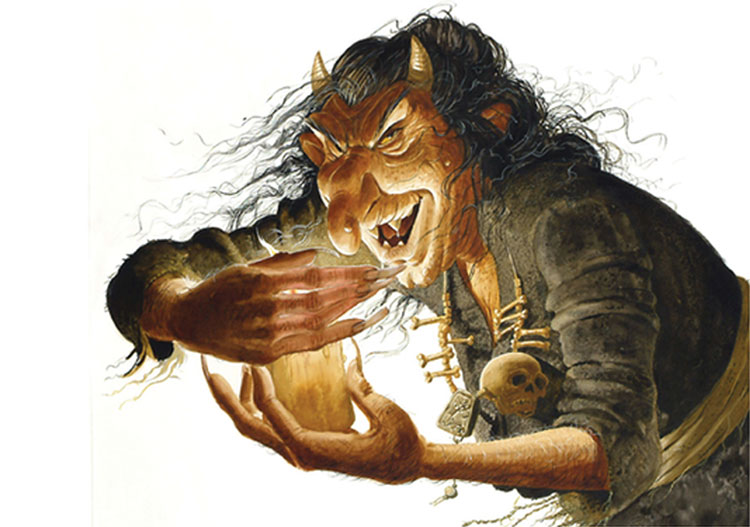
Icelandic legend says that Gryla is a female goblin who lives in the mountains. This evil character has hooves, horns, 13 tails, a large nose and is full of acne.
Gryla’s origins date back to the pagan era and later transformed into a character meant to scare children. On Christmas Eve, Gryla visits towns and cities from the mountains, searching for and catching naughty children. The goblin then returned to the cave with a bag stuffed with crying children, boiled them, and ate them.
7. Hans Trapp
Hans Trapp is a character in the Christmas folklore of the Alsace and Lorraine region of France. Legend says that Trapp was a rich, greedy and evil man who worshiped Satan and was expelled from the Catholic Church. He was banished to the forest, disguised as a straw scarecrow wrapped in clothes to hunt children. He will appear in December before Christmas, threaten bad children, and bring gifts to good children.
This character has many similarities with other monsters such as Belsnickel (Southwest Germany), Houseker (Luxembourg), Knecht Ruprecht (Germany), Krampus (Tyrol, Alto Adige and Trentino), Père Fouettard (other regions of France), Schmutzli (Switzerland), Piet (Netherlands),…
8. Père Fouettard
French legend tells of Père Fouettard as an evil butcher who craved the flesh of children. He or his wife lured three young boys into his butcher shop to kill, dismember and marinate them. Saint Nicholas comes to the rescue, resurrects the boys, and takes custody of the butcher. The imprisoned butcher became Père Fouettard, servant of Saint Nicholas, whose duty was to dispense punishment to bad children on Saint Nicholas Day.
9. Yule Lads
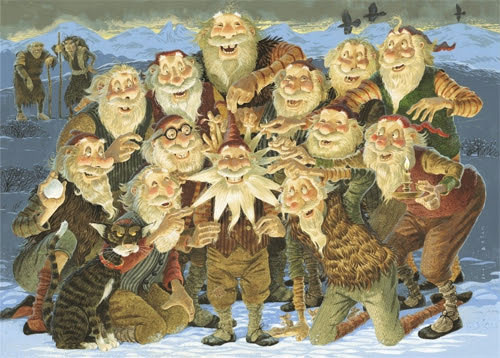
Yule Lads, also known as Jólasveinar, are 13 Icelandic trolls each with a unique name and personality. In ancient times, they stole everything and caused trouble at Christmas, so demons often scared children into behaving, like the Christmas cat. But, since the twentieth century, these devils in Norway, have brought gifts to good children. They can be fierce and scary to bad children and kind to obedient boys and girls.
10. Mari Lwyd
The horse-skull devil (Welsh) often wears a long cloak and is followed by a group of chanting people, creating a spooky atmosphere. This is a character that often appears on the night of the transition to the new year.
11. Kallikantzari
These are goblins that often live underground and choose the time about 12 days before Christmas to emerge, disturbing everyone’s peaceful lives.
In Greece, people have always had the notion that the underground world really exists and there is a tree called the “dead tree” – called Kallikantzari.
This tree can stretch its branches above the ground and take away the people it wants to come to its world, never to return again.
